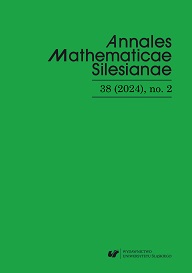F. Antonuccio, Split-quaternions and the Dirac equation, Adv. Appl. Clifford Algebr. 25 (2015), no. 1, 13–29.
Google Scholar
D. Bród, On a new one parameter generalization of Pell numbers, Ann. Math. Sil. 33 (2019), no. 1, 66–76.
Google Scholar
D. Bród and A. Szynal-Liana, On some combinatorial properties of P(r,n)-Pell quaternions, Tatra Mt. Math. Publ. 77 (2020), 1–12.
Google Scholar
P. Catarino, On k-Pell hybrid numbers, J. Discrete Math. Sci. Cryptogr. 22 (2019), no. 1, 83–89.
Google Scholar
P. Catarino, On some identities and generating functions for k-Pell numbers, Int. J. Math. Anal. (Ruse) 7 (2013), no. 38, 1877–1884.
Google Scholar
P. Catarino and G. Bilgici, A note on modified k-Pell hybrid numbers, Konuralp J. Math. 8 (2020), no. 2, 229–233.
Google Scholar
G. Cerda-Morales, Investigation of generalized Fibonacci hybrid numbers and their properties, Appl. Math. E-Notes 21 (2021), 110–118.
Google Scholar
E. Eser, B. Kuloğlu, and E. Özkan, On the Mersenne and Mersenne–Lucas hybrinomial quaternions, Bull. Transilv. Univ. Braşov Ser. III. Math. Comput. Sci. 3(65) (2023), no. 1, 129–144.
Google Scholar
A.F. Horadam, Basic properties of a certain generalized sequence of numbers, Fibonacci Quart. 3 (1965), 161–176.
Google Scholar
C. Kızılateş, A new generalization of Fibonacci hybrid and Lucas hybrid numbers, Chaos Solitons Fractals 130 (2020), 109449, 5 pp.
Google Scholar
E.G. Kocer and N. Tuglu, The Binet formulas for the Pell and Pell–Lucas p-numbers, Ars Combin. 85 (2007), 3–17.
Google Scholar
M. Liana, A. Szynal-Liana, and I. Włoch, On Pell hybrinomials, Miskolc Math. Notes 20 (2019), no. 2, 1051–1062.
Google Scholar
M. Özdemir, Introduction to hybrid numbers, Adv. Appl. Clifford Algebr. 28 (2018), no. 1, Paper No. 11, 32 pp.
Google Scholar
E. Özkan and M. Uysal, Mersenne–Lucas hybrid numbers, Math. Montisnigri 52 (2021), 17–29.
Google Scholar
İ. Öztürk and M. Özdemir, Similarity of hybrid numbers, Math. Methods Appl. Sci. 43 (2020), no. 15, 8867–8881.
Google Scholar
K. Piejko and I. Włoch, On k-distance Pell numbers in 3-edge-coloured graphs, J. Appl. Math. (2014), Art. ID 428020, 6 pp.
Google Scholar
E. Polatlı, A note on ratios of Fibonacci hybrid numbers, Notes Number Theory Discrete Math. 27 (2021), 73–78.
Google Scholar
Y. Soykan and E. Taşdemir, Generalized Tetranacci hybrid numbers, Ann. Math. Sil. 35 (2021), no. 1, 113–130.
Google Scholar
A. Szynal-Liana, The Horadam hybrid numbers, Discuss. Math. Gen. Algebra Appl. 38 (2018), no. 1, 91–98.
Google Scholar
A. Szynal-Liana and I. Włoch, Hypercomplex Numbers of the Fibonacci Type, Oficyna Wydawnicza Politechniki Rzeszowskiej, Rzeszów, 2019.
Google Scholar
A. Szynal-Liana and I. Włoch, On Pell and Pell–Lucas hybrid numbers, Comment. Math. 58 (2018), no. 1–2, 11–17.
Google Scholar
A. Szynal-Liana and I. Włoch, On special spacelike hybrid numbers, Mathematics 8 (2020), no. 10, 1671, 10 pp.
Google Scholar
E. Tan and N.R. Ait-Amrane, On a new generalization of Fibonacci hybrid numbers, Indian J. Pure Appl. Math. 54 (2023), no. 2, 428–438.
Google Scholar
Ü. Tokeşer, Z. Ünal, G. Bilgici, Split Pell and Pell–Lucas quaternions, Adv. Appl. Clifford Algebr. 27 (2017), no. 2, 1881–1893.
Google Scholar
M. Uysal and E. Özkan, Padovan hybrid quaternions and some properties, J. Sci. Arts 22 (2022), no. 1, 121–132.
Google Scholar



 10.2478/amsil
10.2478/amsil